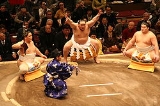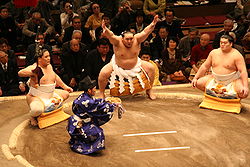
Tachimochi
Encyclopedia

Sumo
is a competitive full-contact sport where a wrestler attempts to force another wrestler out of a circular ring or to touch the ground with anything other than the soles of the feet. The sport originated in Japan, the only country where it is practiced professionally...
, the tachimochi (太刀持ち; lit.: sword carrier) is one of the two attendants that accompany a yokozuna when he performs his dohyo
Dohyo
thumb|A dohyōThe dohyō is the ring in which sumo wrestling bouts are held. A modern dohyo is a circle of rice-straw bales 4.55 meters in diameter, mounted on a square platform of clay 6.7m on a side, and 34 to 60 cm high. The surface is covered by sand.A new dohyō is built prior to each...
-iri or ring entrance ceremony. The other attendant is called the tsuyuharai
Tsuyuharai
In professional sumo, the tsuyuharai is one of the two attendants that accompany a yokozuna when he performs his dohyo-iri or ring entrance ceremony. The other attendant is called the tachimochi....
.
During the ceremony the tachimochi will follow the yokozuna, carrying his sword in his right hand, to the ring and squat on his right hand side. The yokozuna's sword is a traditional indication of his samurai
Samurai
is the term for the military nobility of pre-industrial Japan. According to translator William Scott Wilson: "In Chinese, the character 侍 was originally a verb meaning to wait upon or accompany a person in the upper ranks of society, and this is also true of the original term in Japanese, saburau...
status. After the yokozuna has completed his ceremonial dance the tachimochi will once again follow him off the dohyo.
The tachimochi must be a makuuchi
Makuuchi
or is the top division of professional sumo. Its size is fixed at 42 wrestlers , ordered into five ranks according to their ability as defined by their performance in previous tournaments....
ranked sumo wrestler (or rikishi) and is, if possible, from the same training stable (or heya). If there are no appropriate choices from within the stable then the tachimochi will normally be from another related stable (from the same stable grouping called an ichimon). The tachimochi is always the higher ranked wrestler of the two attendants.
All three wrestlers will wear a matching set of kesho-mawashi belonging to the yokozuna during the ceremony, and as the ceremony is directly after the ring entry ceremony for the makuuchi division wrestlers on a tournament day this means that the tachimochi will also wear the yokozuna's kesho-mawashi for his own entrance.
A wrestler who is scheduled to fight the yokozuna on a particular day of a honbasho
Honbasho
A is an official professional sumo tournament. There are six held each year, a system established in 1958. Only honbasho results matter in determining promotion and relegation for rikishi ....
(or tournament) will not act as his tachimochi.
In normal circumstances, the tachimochi will not be another yokozuna or an ozeki. An ozeki can act as a tachimochi during a wrestler's very first dohyo-iri, held at Meiji Jingu
Meiji Shrine
', located in Shibuya, Tokyo, is the Shinto shrine that is dedicated to the deified spirits of Emperor Meiji and his wife, Empress Shōken.-History:...
in Tokyo
Tokyo
, ; officially , is one of the 47 prefectures of Japan. Tokyo is the capital of Japan, the center of the Greater Tokyo Area, and the largest metropolitan area of Japan. It is the seat of the Japanese government and the Imperial Palace, and the home of the Japanese Imperial Family...
. A yokozuna will only usually fulfil this role at another yokozuna's retirement ceremony, or at a special event after the other yokozuna has announced his retirement, but before the final ceremony.

